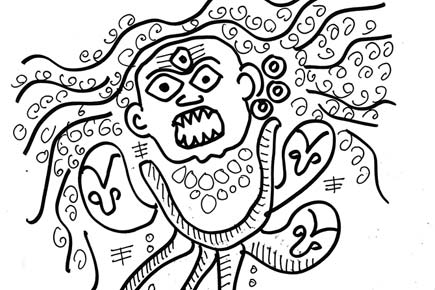Bhairava, Rudra and Vira-bhadra are three forms of Shiva that are often confused with each other

 Bhairava, Rudra and Vira-bhadra are three forms of Shiva that are often confused with each other. They all look fierce, with fangs and bloodshot eyes, and are associated with dogs. But they are different.
Bhairava, Rudra and Vira-bhadra are three forms of Shiva that are often confused with each other. They all look fierce, with fangs and bloodshot eyes, and are associated with dogs. But they are different.
ADVERTISEMENT
The name Bhairava is derived from ‘bhaya’ or terror. The name Rudra is associated with ‘rudan’ or mournful howling. And the name Vira-bhadra embodies heroic (vira) and righteous (bhadra) outrage. Bhairava is the companion of the Goddess. Rudra is associated with the beheading of Brahma when he chases and seeks control of the Goddess. Vira-bhadra is associated with beheading of Daksha Prajapati, the stubborn patriarch. Bhairava is not explicitly associated with such violence, even though he is shown holding a severed head of a man.

Illustration/Devdutt Pattanaik
Essentially, Rudra and Vira-bhadra are associated with anger. Not Bhairava. Bhairava does not respond to a state of helplessness that evokes anger. He is simply embodying the emotion of terror, one that makes us aware of death, hence life. Perhaps that is why he is a popular deity of Tantrikas, who associate him with ‘vi-gyana’ or wisdom, born when ‘gyana’ or received knowledge is churned in the mind.
Alcohol is offered to Bhairava. Is the alcohol that is offered to him meant to take away fear? Or is the alcohol meant to remove inhibitions that unleash our terrifying actions? Contemplating on Bhairava forces us to understand deeply and clearly the nature of terror.
In nature, there is terror, but no terrorists, there is violence, but not violation. There is the petrified predator who fears death by starvation and the petrified prey who fears death by predation. There are fights over territory and mates and on establishing pecking order. Terrorism is an outcome of human civilisation where there are boundaries and entitlements. Humans create property and grand themselves legitimacy at the cost of other humans. There is a continuous struggle for power, with the powerless seeking ‘rights’ and the powerful seeking ‘entitlements’.
Bhairava makes us question who is the terrorist? Terrorists who bomb developed nations, or the developed nations who bomb developing nations and create an ecosystem that breeds terrorists? Are terrorists those who kill innocent civilians or those who justify violent vengeful drone attacks? Who is more terrifying — the hyper-critical Left or the hyper-sensitive Right? Islamophobia or Hinduphobia or homophobia? The rapists, or the system that feels rapists also need protection? The system that vaporises the rich, or the system that glamorises the poor? The system that deprives the minorities of power, or the system that strips the majority of authority? Tradition or revolution?
Can the poor frighten the rich? Can the powerless frighten the powerful? Why else would the rich and powerful barricade themselves with security firewalls and visa rules? Perhaps we are too busy protecting victims to see the fear of the villain. We assume that by attacking and controlling villains, we can help victims. Maybe we are simplify amplifying the fear, hence villainy, of the villains. The more you attack or shame the villain, the more terrifying he becomes, as he digs his heels and refuses to back down. And thus we contribute to the cycle of terror. Bhairava, companion of the Goddess, points us to darkest aspects of human psychology, that aspect of the mind that wants our gods to be indulgently cherubic or constantly outraged.
The author writes and lectures on the relevance of mythology in modern times. Reach him at devdutt@devdutt.com
 Subscribe today by clicking the link and stay updated with the latest news!" Click here!
Subscribe today by clicking the link and stay updated with the latest news!" Click here!







